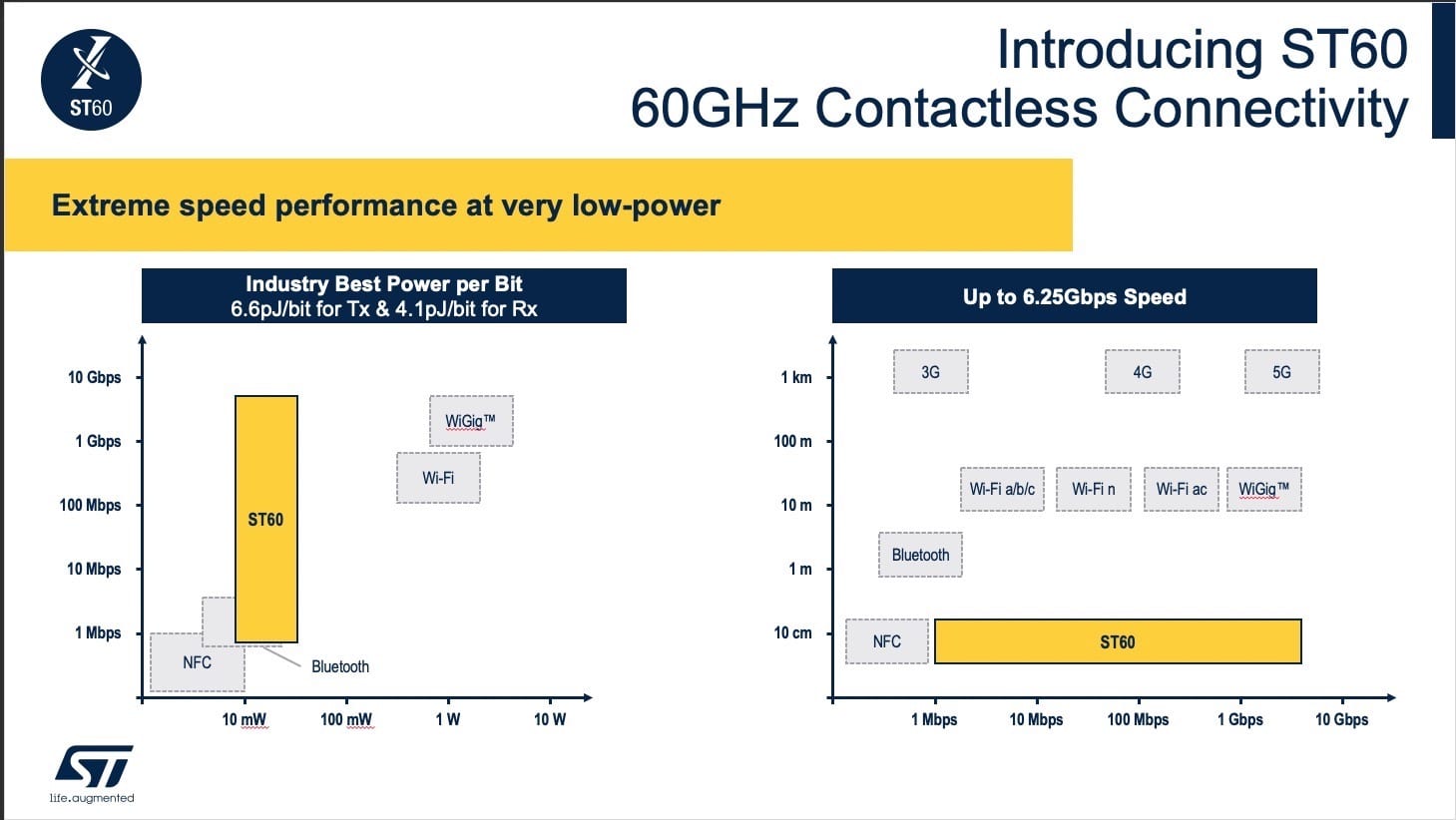The ST60 is ST’s first millimeter wave RF transceiver operating on the 60 GHz unlicensed V band, and it enables very low-power as well as short-range but high data rate, contactless point-to-point, and ultra-low latency connections for cable-free and connector-free solutions. It delivers up to 6.25 Gbit/s for board-to-board connections, thus enabling the creation of video links or fast data exchanges. It can also pass through materials such as plastic, plexiglass, and wood, and other non-conductive materials. The ST60 opens the way for the creation of more robust designs by avoiding the mechanical stress that often befalls connectors or wires. Moreover, it can seamlessly replace wired solutions like Gigabit Ethernet, SLVS, or UART. The transceivers also offer the industry’s lowest power per bit at 6.6 pJ/bit in transmitter mode (Tx) and 4.1 pJ/bit in receiver mode (Rx).
The Benefits of Using a Contactless Module in Various Applications

Extremely high frequency (EHF) radio uses a spectrum between 30 GHz and 300 GHz and its wavelengths vary approximately from one to ten millimeters. EHF is nothing new but the 60 GHz V Band has the advantage of not requiring a license nor does it interfere with telecommunication protocols that either use lower or higher frequencies. It thus constitutes a power-efficient alternative to physical cables and connectors in a wide range of applications, from industrial or medical equipment to smartphones, consumer electronics, many computer peripherals, as well as automotive and aeronautical systems. When harsh environments force industries to invest in more expensive connectors resistant to dust, salt, or vibrations, or when a cable limits movements, contactless connectivity increases robustness and reliability. Recent events also highlighted the fact that the ST60 can reduce the risk of contamination by medical equipment since there is no cable carrying germs or viruses.
The ST60 is also reshaping industries that use expensive coaxial cables. When coupling the device to a waveguide, it increases its reach and can, therefore, ensure a high and steady data transfer despite longer distances. It can also allow machines to communicate with one another to create smarter factories that can additionally test consumer devices, like smartphones, without needing to plug cables. A contactless experience can also improve the end-user experience by making it easier to share information. Finally, digital signage or event planners can more easily build display walls without cumbersome cables. Put simply, the EHF has an extensive scope and it was important for ST to offer a device as soon as possible to help early adopters transition.
ST60: The 60 GHz Transceiver That Adapts to Your Needs
Products that benefit from a 60 GHz RF contactless module are increasingly popular, but compared to other competing solutions, the ST60’s meager 25 mW to 40 mW enables engineers to put it in low-power designs. Moreover, jointly used with low-power STM32 microcontrollers, the ST60 can integrate small battery-powered systems capable of offering flexible and contactless communications, something that was just impossible a few years ago. On the other hand, designers can aggregate multiple ST60 to take advantage of multi-link communications and increase the overall bandwidth to tackle much more demanding applications, such as cable replacement for display panels like TVs or computer monitors and laptop screens.
The ST60’s pragmatism also extends to the fact that it takes a lot less space than a traditional cable connector thanks to its small package and the absence of additional components aside from a few resistors. It integrates a lot of components, so designers don’t need to add an external clock or value, thus greatly simplifying the design and reducing the bill of materials. And with a latency of only a few nanoseconds, there are no compromises to the user experience.
Unlike the competition, which only offers a fixed antenna inside the transceiver’s housing, the ST60 enables flexible antenna configurations to best fit customer applications. An external antenna means engineers can select a model with vertical or horizontal radiation patterns, linear or circular polarization, and better fine-tune the gain. We also offer a version of the ST60 that will include an antenna for designers seeking a smaller footprint and ready-to-use solution.
The 60 GHz Transceiver That Works in Your Environments
We already see the positive feedback from partners experimenting with the ST60. It is a competitive alternative to cables when constructing a wall full of displays, making their installation a lot easier and faster. Our demos at CES and Embedded World showed how it could reliably transmit and receive videos wirelessly. We could also envision untethered security cameras or industrial robots with much greater freedom of movements thanks to their contactless connection capabilities. Finally, we tested our ST60 and ensured that it wasn’t interfering with Bluetooth, Wi-Fi or cellular modules, meaning that a phone manufacturer can use it to facilitate file-sharing or docking operations inside a smartphone or tablet. The ST 60 can also work in industrial settings since it supports temperatures from -40 ºC to +105 ºC.
